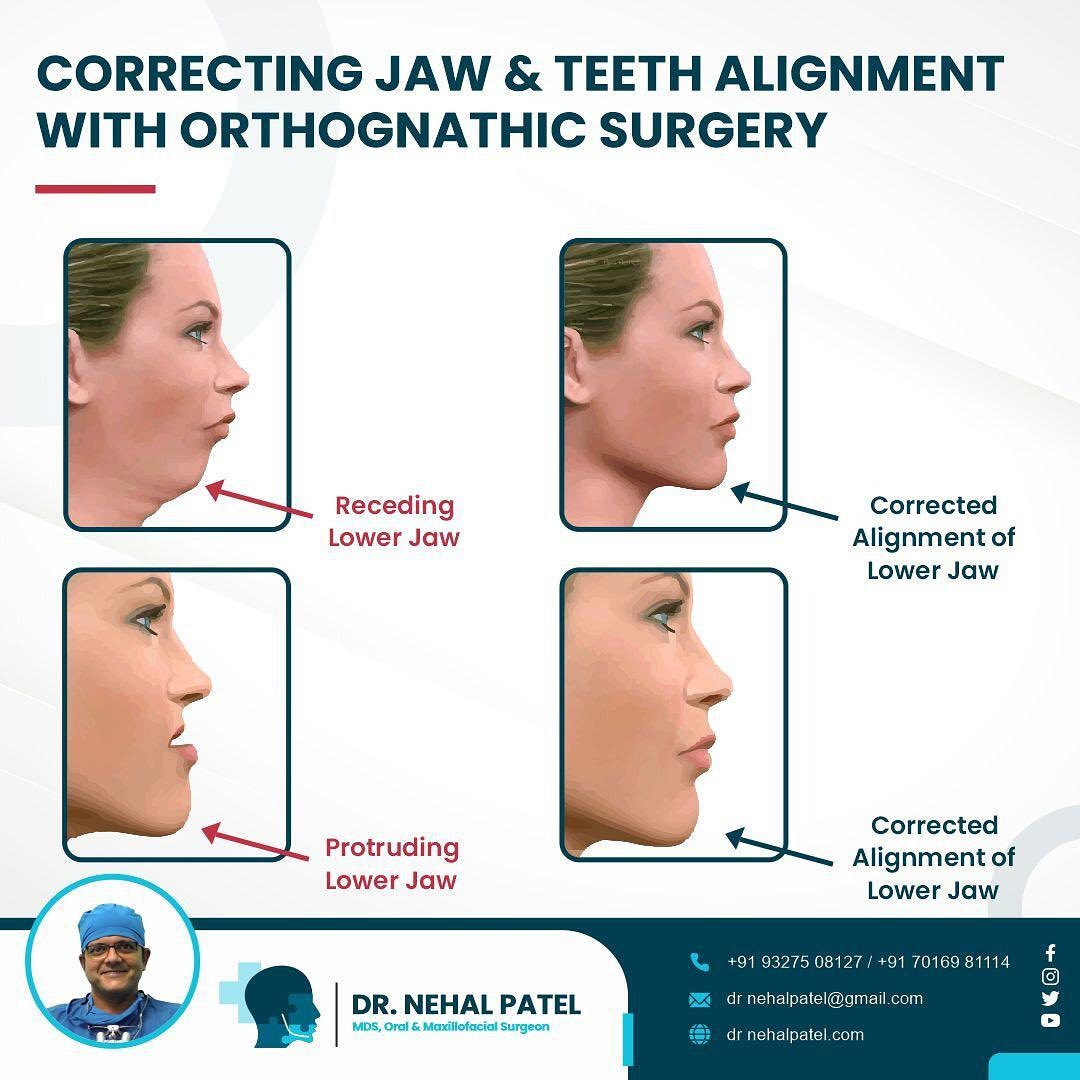What is Prognathism? Identifying and Treating Jaw Alignment Issues
Prognathism is a condition where the jaw protrudes or is misaligned, resulting in an abnormal relationship between the upper and lower jaw. This misalignment can affect the way you bite, chew, and even speak. While it can be hereditary, it’s often a result of other underlying health issues. In this blog, we’ll delve into the causes, symptoms, and treatment options for prognathism, along with how an Oral and Maxillofacial surgeon like Dr. Nehal Patel can help restore function and facial harmony.
What is Prognathism?
Prognathism is defined as the forward projection of either the lower jaw (mandibular prognathism), the upper jaw (maxillary prognathism), or both. This condition not only affects facial aesthetics but also the function of the jaw, leading to problems with eating, speaking, and maintaining oral health.
Types of Prognathism:
Mandibular Prognathism: In this case, the lower jaw juts out further than the upper jaw, resulting in an underbite.
Maxillary Prognathism: Here, the upper jaw is positioned more forward, causing an overbite or open bite.
Bimaxillary Prognathism: This occurs when both the upper and lower jaws protrude.
Causes of Prognathism
The development of prognathism is typically influenced by genetics, but other factors can play a role as well. These include:
Inherited traits: Family history often determines the likelihood of jaw misalignment.
Growth disorders: Conditions like acromegaly or certain genetic syndromes may contribute to excessive jaw growth.
Developmental issues: A jaw that doesn’t grow in proportion to the rest of the face during childhood can result in prognathism.
Facial Trauma: Injuries or fractures to the jaw can affect its alignment and development over time.
Dental issues: Habits like thumb-sucking or prolonged use of pacifiers in childhood can affect jaw alignment, contributing to prognathism.
Symptoms of Prognathism
Identifying prognathism can be crucial in preventing long-term dental and functional issues. Some common symptoms include:
Difficulty biting or chewing: Misaligned jaws can lead to an improper bite, causing discomfort while eating.
Speech difficulties: The positioning of the jaw can interfere with clear speech, especially in severe cases.
Jaw pain or discomfort: Misalignment often leads to tension and pain in the jaw joint, particularly in the temporomandibular joint (TMJ).
Facial asymmetry: One of the most noticeable symptoms of prognathism is the abnormal appearance of the face, especially when the jaw is over- or under-developed.
Breathing issues: In severe cases, prognathism may interfere with normal breathing, especially during sleep.
Diagnosing Prognathism
If you suspect you have prognathism, an Oral and Maxillofacial surgeon like Dr. Nehal Patel can provide an accurate diagnosis. The diagnostic process typically includes:
Physical examination: A thorough examination of your facial structure, jaw, and teeth alignment.
X-rays and imaging: Radiographs or 3D imaging help visualize the jaw and any underlying skeletal problems.
Dental impressions: Models of your teeth can reveal the extent of the misalignment and how it affects your bite.
Treatment Options for Prognathism
The treatment for prognathism depends on the severity of the condition, the patient’s age, and other health factors. Treatment options can range from orthodontic correction to surgical intervention.
Non-Surgical Treatments:
Orthodontic Surgery: In mild cases, braces or other orthodontic appliances can help realign the teeth and correct the bite, improving the overall function and appearance of the jaw.
Retainers and corrective devices: These may be used to gradually shift the jaw back into place over time, particularly in younger patients whose jaws are still growing.
Surgical Treatments:
In more severe cases of prognathism, surgery may be necessary to realign the jaw and restore proper function.
Orthognathic Surgery: This surgical procedure involves repositioning the jaws for proper alignment. The surgery can correct both functional and aesthetic concerns. Depending on the type of prognathism, either the upper jaw, lower jaw, or both may need to be realigned.
Genioplasty: In some cases, genioplasty (chin surgery) can be used in conjunction with orthognathic surgery to achieve the desired aesthetic and functional outcomes, particularly for mandibular prognathism.
Maxillary or Mandibular Osteotomy: These procedures involve cutting and repositioning the upper or lower jaw, then securing it in its new position with screws and plates. This is typically done in conjunction with orthodontic treatment.
Get Advanced Treatment with the Best TMJ Specialist in India
If you are dealing with jaw misalignment or experiencing discomfort due to prognathism, seeking professional help is crucial for restoring both function and confidence. Dr. Nehal Patel, a Best Oral and Maxillofacial Surgeon in India, is known for his expertise in TMJ Arthroscopy, Orthognathic Surgery, and complex jaw realignment procedures. With over 6,000 successful surgeries to his name, Dr.Nehal Patel is trusted by patients across India.
Dr. Nehal Patel and his team at nuFace Maxillofacial & Dental Hospital specialize in corrective jaw surgeries that can enhance your quality of life by addressing functional and aesthetic concerns related to prognathism. Whether it’s through surgical intervention or non-invasive treatments, you can be assured of receiving personalized care and advanced solutions for your condition.
Conclusion
Prognathism can have a significant impact on both your appearance and overall oral health. Understanding the causes, symptoms, and treatment options is essential for making informed decisions about your care. Whether you're considering orthodontic correction or surgical treatment, consulting a highly skilled Oral and Maxillofacial Surgeon like Dr. Nehal Patel can provide you with the expertise needed to restore both function and facial harmony.
If you're struggling with jaw misalignment or experiencing discomfort, don't hesitate to reach out to Dr. Nehal Patel for an evaluation and explore the best treatment options available.


